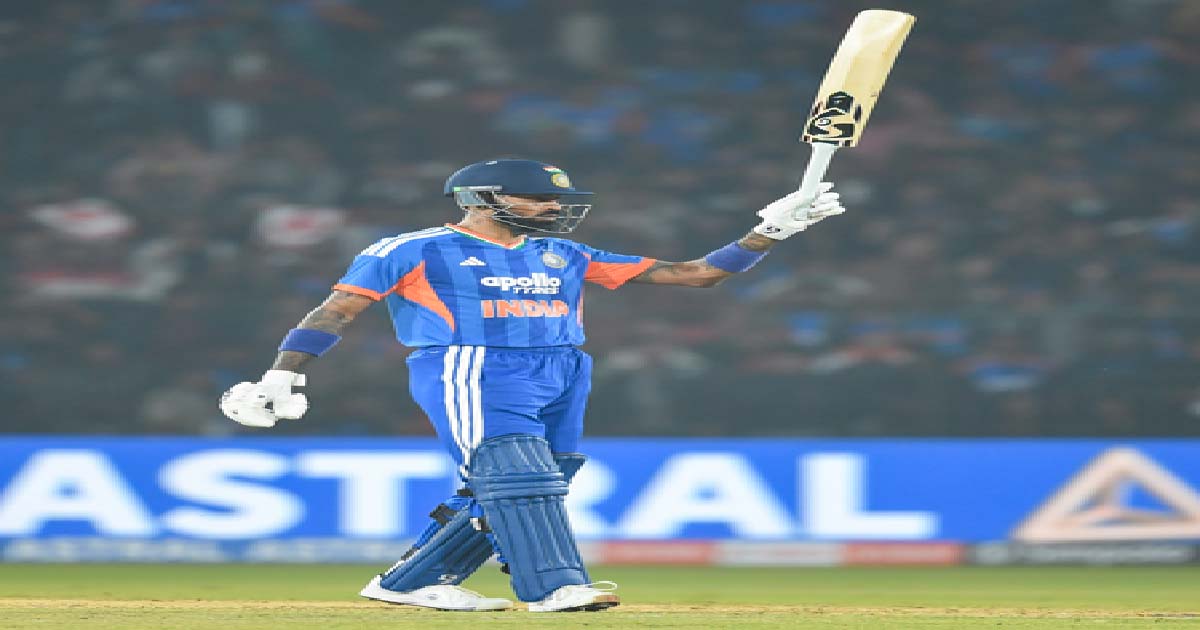Sports
T20 getting to be similar to a chess game

Cricket’s T20 format was an attempt to liven up the game and make it viewer friendly. This has proven to be a success and a lifeline for the game of cricket. Every match around the world is filled with loud, active and boisterous spectators bursting with enthusiastic energy. It reminds one of the Colosseum, where gladiators fought for their life and prestige during the days of the Roman Empire.
T20 cricket evokes a very similar attachment and emotion among the crowd, however, without the actual blood-thirsty response of yore.
The early days of T20 cricket was looked upon as a slam-bang version, wherein, thoughtless cross-bat heaves and stroke-play was the norm to follow. Yuvraj Singh, hitting 6 sixes off a Stuart Broad over, in the first ever T20 World Cup was the epitome of every batter’s desire. India, winning the Cup in 2007 was just the tonic that the doctor ordered to get the Indian fans activated.
The Indian Premier league (IPL) in 2008 had sceptics who felt that cricket was being sacrificed for commercial gains and that the sport will lose its character and the values that it stands for. The gentleman’s game that revelled in artistic stroke-play, would breed swatters who would do well killing flies. A brilliant 158 runs by Brendon McCullum from New Zealand off just 73 balls for Kolkata Knight Riders in the inaugural match of the IPL in 2008 was an eye opener. He played correct, conventional and courageous cricket shots, that not only made one admire his innings but it also became the precursor for others to follow. It gave just the boost required not only to the T20 format but also to the most lucrative cricket league in the world, the IPL.
Chris Gayle, the powerful and strong West Indian cricket star with his lusty hits, became the superstar of the IPL and one every batter wanted to emulate. Cricket changed from being a game of a number of runs scored to strike-rates, indicating the number of balls faced to get them.
Cricket, therefore, came alive with batters ready to strike and attack. The fast pace of the game forced cricketers to get more agile, fit and thereby look like well-sculptured athletes. The cameras at all corners of the field highlighted every move they made and the slow motion replays became a luxury to enjoy. A cricket match developed into a mystery story of an uncertain ending, as well as giving rise to heroes and villains as it progressed — an entertainment for the family to partake in.
The slam-bang approach of the initial T20 theory gradually gave way to a more planned and strategy-driven concept. Players, matches and conditions were being analysed to the ultimate degree by IT professionals and teams of skilled support staff, utilising the data and findings extensively for their use.
T20 cricket has gradually changed by leaps and bounds. It has become a chess match between two teams, each making moves and thinking steps ahead. Yuzvendra Chahal, the wily leg-spinner and a reputed chess player himself, in a recent interview, stated as to how he studies the batsman to outthink him. Interestingly, the game has become a mental battle between the batter and the bowler. Each one is trying to read the other to outsmart one another.
The batsman has a hint of what the bowler has in mind by the field placement put in place. However, many bowlers have outfoxed the batsman by playing a dummy move. A batter still has an advantage with bowlers having a width restriction as well as a restriction of fielders outside the 30-yard circle. The bowlers have also innovated in a major way. The variety of deliveries that many have now skilled themselves to bowl are quite remarkable and innovative.
Cricket has never had such a transformation like what it is going through in the last decade. Innovative and unimaginable strokes by the batters and varieties of variable deliveries being churned out by bowlers, has made cricket into a very different game from that in the past.
The chess board comes so much into prominence in the present T20 world of cricket. Many pawns are sacrificed and rooks, bishops and knights moved to strategise a victory. A Queen is an all-rounder who could, through batting or bowling, change the complexion of the game. The King is the citadel that every franchise team is protecting, through planned strategies and thoughtful moves to avoid a checkmate.
Cricket finally has become a game of brain as well as brawn — one that requires a cricketer to think correctly and to implement forcefully. The T20 format has totally revolutionised cricket for years to come.
One feels Test cricket will never be the same again. The modern cricketers are products of the fast changing digital world, wherein speed is important for progress. The laggards will be left behind.
Chess too has a ‘Rapid’ version to it. T10 cricket could be the next one to follow. One wonders what new innovation will come forth then.
Crime
One more accused arrested for vandalism during Lionel Messi’s Kolkata event

Kolkata, Dec 17: One more person has been arrested in connection with the vandalism during Lionel Messi’s event at Salt Lake Stadium on December 13, taking the number of those arrested to six, the Bidhannagar police said on Wednesday.
Meanwhile, a Special Investigation Team (SIT), formed by the West Bengal government on Tuesday, began its probe into the matter.
According to police sources, the sixth arrest was made late on Tuesday night. The arrested person has been identified as Rupak Mandal. Police sources said that the accused will be produced before the Bidhannagar Sub-Divisional Court and charged with vandalism, creating disorder and disrupting law and order at the Yuva Bharati Krirangan.
The sources also said that several other individuals are suspected of being involved in the incident, and they may also be interrogated, if necessary. It has also been hinted that the number of arrests may increase in the coming days based on the progress of the investigation, and once the examination of CCTV and other video footages are completed.
The sources stressed that they are investigating how the situation spiralled out of control on the day of the incident, who directly participated in the vandalism, and who instigated the violence from behind the scenes. It was learnt that investigators are separately analysing the role of each arrested accused.
Noting the seriousness of the incident and the questions raised about security arrangements at Yuva Bharati, one of the state’s most prominent sports stadiums, the state government has formed the SIT, which will focus on how the disorder spread at the Yuva Bharati Krirangan, where the security lapses occurred, and whether there was any negligence on the part of the responsible agencies or officials.
According to administrative sources, the SIT members visited the Yuva Bharati Krirangan on Wednesday. They are inspecting the site, assessing the extent of the vandalism, and the amount of damage. After reviewing the situation, they will prepare a detailed report on the security arrangements on the day of the incident.
Meanwhile, following this incident, the administration is considering strengthening security measures for future large-scale events at the Yuva Bharati Krirangan. It includes ensuring adequate police surveillance, increased security checks at entry points and the use of modern technology to control crowds.
On December 13, the Salt Lake Stadium was full long before Messi’s event began, with spectators waiting to see their favourite footballer.
As soon as Messi arrived, many people surrounded him, trying to take pictures. As Messi’s security guards were also there, a chaotic situation prevailed overall, and spectators complained that they couldn’t even see him.
Messi left the field within just 22 minutes. After that, vandalism began. Chairs and bottles were thrown onto the field from the stands. Many spectators broke down the gates and entered the field.
Vandalism occurred in the galleries and restrooms of the Yuva Bharati Krirangan. Following this incident, the state government formed an investigation committee. Event organiser Satadru Dutta was arrested. On Tuesday, Aroop Biswas resigned as state Sports Minister while top IPS officers, including DGP Rajeev Kumar, were issued a show-cause notice.
National News
Team India has benefited immensely from Hardik’s ability: Bangar

New Delhi, Dec 17: Former India batting coach Sanjay Bangar highlighted Hardik Pandya’s impact with bat and ball, stating that the Men in Blue have benefited massively because of the all-rounder’s abilities.
Pandya returned to competitive cricket earlier this month after missing out for over two months due to the injury he sustained during the Asia Cup semi-final in September. He made an immediate impact in the game for the Men in Blue and played a crucial role in the team’s successful outings against South Africa in the ongoing five-match T20I series.
Speaking to JioStar, Bangar lavished praise on Pandya, emphasising the Baroda cricketer’s unique batting mechanics and his value as a bowling option in T20 cricket, as he said, “Going deep inside the crease is Hardik Pandya’s speciality.
Even when he goes that deep, his weight remains on the front foot, which is a very good thing. As a batter, we always encourage waiting for the ball. He plays with a very wide base, which allows him to generate a lot of power.”
“He can play front-foot shots, back-foot shots, baseball-style hits, full shots and the upper cut. He opens up both sides of the ground, which is a special ability. He bowls at around 132–133 kmph with a fuller length, where close to 54 per cent of his deliveries are pitched up, and he gets wickets from there. He allows the ball to swing, and when required, he goes for the yorker as well. The Indian team has benefited immensely from his ability,” he added.
Bangar highlighted Abhishek Sharma’s fearless approach, underscoring the technical elements that enable the young batter to dominate bowlers. Opining on his attacking mindset, Bangar stated, “First of all, it’s his attacking mindset. If there’s a delivery outside the off stump, he hits it very hard. One very important aspect of his batting is his high backlift. He holds the bat above the handle, which gives him excellent reach. Because of the swing he generates, he can hit big sixes, especially over the covers. Hitting sixes over the covers is a special ability. He doesn’t try to hit from below, which gives him an incredible range.”
Turning his attention to Shubman Gill, Bangar acknowledged the Indian opener’s form while pointing out specific areas that need refinement, particularly against straight deliveries.
“In the beginning, his footwork was very positive. But if you remove three or four boundaries over 28 games, the issue has been on straighter lines. Against straight deliveries, his strike rate has fallen quite low. Outside the off stump, his strike rate is good, but there have been a few edges as well.
Overall, he has scored runs, but straight-line play is something he will want to improve. In the second game, the ball that got him out was a very good delivery—it could have dismissed any batter. His footwork has improved, and if he continues to play with clear footwork, he will be able to hit the same shots consistently, like the three or four boundaries we’ve seen,” he noted.
While India have enjoyed the upper hand in the series so far, Bangar cautioned against underestimating South Africa, particularly with the conditions on offer in Lucknow, saying, “The way this series has gone, South Africa has fought well in every format. On the Lucknow pitch, there is bounce and seam, and South Africa’s fast bowlers will look to make early inroads. India will need to be prepared for that challenge.”
With India holding a 2–1 advantage in the five-match T20I series against South Africa, the spotlight now turns to Lucknow for the fourth game, as the two sides gear up to face off at the Bharat Ratna Shri Atal Bihari Vajpayee Ekana Cricket Stadium on Wednesday.
National News
Mamata Banerjee announces judicial committee to probe chaos at Salt Lake Stadium over Lionel Messi’s visit

Kolkata, Dec 13: With chaos and vandalism breaking out at Salt Lake Stadium on the northern outskirts of Kolkata on Saturday over high ticket prices and limited access to Argentinian soccer star Lionel Messi during his visit to the stadium, West Bengal Chief Minister Mamata Banerjee announced setting up a judicial committee headed by a retired judge of the Calcutta High Court to probe the mismanagement that led to the chaos.
With the agitators resorting to a rampage within the stadium over limited access to Messi despite purchasing tickets at exorbitant prices, the police had to resort to a massive lathi charge and deploy Rapid Action Force (RAF), following which the Argentinian soccer star left the stadium early.
The Chief Minister was on her way to the stadium. However, on receiving the news of the ruckus at the stadium, she directed her driver to turn back the car. Soon after that, she issued a statement announcing her decision to set up a judicial committee headed by a retired judge of the Calcutta High Court to probe the mismanagement that led to the chaos.
“I am deeply disturbed and shocked by the mismanagement witnessed today at Salt Lake Stadium. I was on my way to the stadium to attend the event along with thousands of sports lovers and fans who had gathered to catch a glimpse of their favourite footballer, Lionel Messi. I sincerely apologise to Lionel Messi, as well as to all sports lovers and his fans, for the unfortunate incident,” the Chief Minister said in her social media statement.
Announcing the decision to form the judicial probe committee, she said that the committee will be headed by Justice (Retd) Ashim Kumar Ray. The state chief secretary, Manoj Pant, and the additional secretary to the state home and hill affairs department, Nandini Chakraborty, will be the two other members of the probe panel.
“The committee will conduct a detailed enquiry into the incident, fix responsibility, and recommend measures to prevent such occurrences in the future. Once again, I extend my heartfelt apologies to all sports lovers, the Chief Minister added.
-

 Crime3 years ago
Crime3 years agoClass 10 student jumps to death in Jaipur
-

 Maharashtra1 year ago
Maharashtra1 year agoMumbai Local Train Update: Central Railway’s New Timetable Comes Into Effect; Check Full List Of Revised Timings & Stations
-

 Maharashtra1 year ago
Maharashtra1 year agoMumbai To Go Toll-Free Tonight! Maharashtra Govt Announces Complete Toll Waiver For Light Motor Vehicles At All 5 Entry Points Of City
-

 Maharashtra1 year ago
Maharashtra1 year agoFalse photo of Imtiaz Jaleel’s rally, exposing the fooling conspiracy
-

 National News1 year ago
National News1 year agoMinistry of Railways rolls out Special Drive 4.0 with focus on digitisation, cleanliness, inclusiveness and grievance redressal
-

 Maharashtra1 year ago
Maharashtra1 year agoMaharashtra Elections 2024: Mumbai Metro & BEST Services Extended Till Midnight On Voting Day
-

 National News1 year ago
National News1 year agoJ&K: 4 Jawans Killed, 28 Injured After Bus Carrying BSF Personnel For Poll Duty Falls Into Gorge In Budgam; Terrifying Visuals Surface
-

 Crime1 year ago
Crime1 year agoBaba Siddique Murder: Mumbai Police Unable To Get Lawrence Bishnoi Custody Due To Home Ministry Order, Says Report












